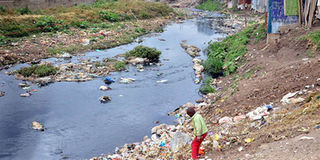How Nairobi River lost pollution battle

This image taken on August 15, 2019 shows a polluted Nairobi River. Most of the industries find it cheaper to discharge their effluent into the water system rather than treat it. PHOTO | FRANCSI NDERITU | NATION MEDIA GROUP
What you need to know:
- In colonial logic, as long as the health of Europeans was not affected, the emerging sanitation and hygiene problem of Nairobi River was inconsequential.
- Because of drinking poisoned waters, dysentery accounted for more than 16 per cent of all deaths of Africans in Nairobi.
Fish and other aquatic life used to thrive here. Not anymore.
Today, the smelly sludge that is the Nairobi River would hardly pass for water. It is dark, oily, putrid and the most abused water system in the region.
How Nairobi River was deliberately poisoned is contained in reports on the early sanitation of the emerging town — with warnings that a bad precedent was being set by allowing raw sewage into the crystal waters close to the emerging city.
By then, Nairobi relied on a small dam near Chiromo which supplied water by gravity to the railway station and its quarters.
Nairobi started on an inauspicious note and, like all colonial cities, had no drainage.
The reasoning then was that nobody thought that a town would emerge in such a dry terrain which had no minerals.
Emerging cities such as Cairo and Johannesburg were all strategic. They were either ports or had minerals. Nairobi had none of these.
DRAINAGE
Thus, Nairobi started with no sewers and drains and, when it rained, the storm water turned it into a “sea of mud” as one writer described it.
“Much of the soil was black cotton, which didn't drain well in the rains.” There was adequate water supply from the nearby Nairobi River and the Mbagathi River.
Railway engineer Sir Joseph Whitehouse had selected this site because it had water but, more importantly, it was the last flat space for the railway engineers as they prepared to climb up the Kikuyu Escarpment and down the Rift Valley.
It was thus ideal for base camps and other engineering needs. Soon, the railway tents morphed into buildings.
“The site Whitehouse identified was actually miserable, in the rainy seasons the soils turned into a spongy, black cotton-like substance that formed part of the embryonic Nairobi,” as vividly described by Richard Modlin in his book Malachite Lion.
PAPYRUS SWAMPS
So bad was the situation that in 1912, the Nairobi Sanitation Commission was appointed to look into the matter because, when the mud dried, it left a fine dusty powder responsible for a respiratory tract infection then known as “Nairobi Throat”.
By that time, a medical officer, Glasgow University-trained Henry Albert Boedeker, had been appointed to look at the Nairobi problem.
Nairobi was having another challenge: Papyrus swamps marked the area around Museums Bridge, modern-day University of Nairobi grounds, Kijabe Street and the entire Kirinyaga Road valley.
While the papyrus swamps were overcome by digging trenches and planting eucalyptus trees by then-administrator John Ainsworth — the man who planted blue gum trees in Nairobi — the problem of drainage was not resolved.
It was these problems that led to the appointment of the Sanitation Commission but, by then, pollution of the Nairobi River — including rats and the plague — was seen as an Indian problem.
DISCRIMINATION
In colonial logic, as long as the health of Europeans was not affected, the emerging sanitation and hygiene problem of Nairobi River was inconsequential.
A segregated system was recommended in 1907 with Africans, Asians and Europeans allocated different areas.
The Indian Bazaar, the modern-day Biashara Street, was the most-neglected area with terrible sanitary facilities compared to European quarters.
Actually, in 1901 the Indians had filed a case against the Township Committee about the unsatisfactory sanitation situation at the Bazaar.
“The Indian commercial district and the bazaar sprawls over several acres and adjacent to it is the market for produce, vegetables and meat. The filth is incredible.
"Meat and other edibles hang within inches of human odour and all of it stinks in the tropical sun…It is evidently thought proper the sewage should run along open cement channels and into a river from which most of the population draws its water,” observed Elspeth Huxley, one of the early colonial writers.
FARM WATER
What the Commission found was rather shocking: “One of the irrigation trenches receives all the foul water sewage of the Indian Bazaar, River Road and surrounding district. This trench is used for irrigating the market gardens where large quantities of vegetables are grown for use of the town.”
More than 100 years later, Nairobi residents are still eating vegetables grown with sewage water.
It also found that “much of the sewage as is not absorbed by the market gardens runs directly into the river which is used for drinking and domestic purposes by Natives (meaning Africans) and Asiatics (Indians).
Because of drinking poisoned waters, dysentery accounted for more than 16 per cent of all deaths of Africans in Nairobi.
On July 29, 1913, Price Williams, a civil engineer from Westminster, arrived in Nairobi and protested about the town's drainage.
Archival information shows that by that time, raw sewage from Nairobi was being drained into Nairobi River without treatment.
TREATMENT
Nobody had bothered to enquire whether there were communities downstream that relied on the Nairobi River water and, over time, Nairobi has acted as a major depository of waste from both domestic and industrial sources.
While appearing before the Sanitary Commission, Williams had warned that "the precedent set up by the main town in the protectorate discharging its sewage untreated into the river, would be an extremely bad one and one which, in my opinion, ought not to be thought of for one moment."
He recommended that the sewerage be treated by storing it in sedimentation tanks and then filtered by continuous filters before being discharged into the Nairobi River “at some point".
Although this was briefly implemented, the industries that rose up in Nairobi continued to drain their water into Nairobi River and the clean waters lost their colour forever.
EFFLUENT
A precedent had been set and Nairobi River was never to be the same.
Today, the riparian reserves of the river are dotted with numerous informal settlements without sewerage and sanitation services and which discharge their raw sewage into the rivers.
More so, most of the industries find it cheaper to discharge their effluent into the water system rather than treat it.
The government has always admitted that the Nairobi River is deliberately polluted with “effluent from industries, unplanned settlements and uncollected garbage”, but nothing seems to have been done.




